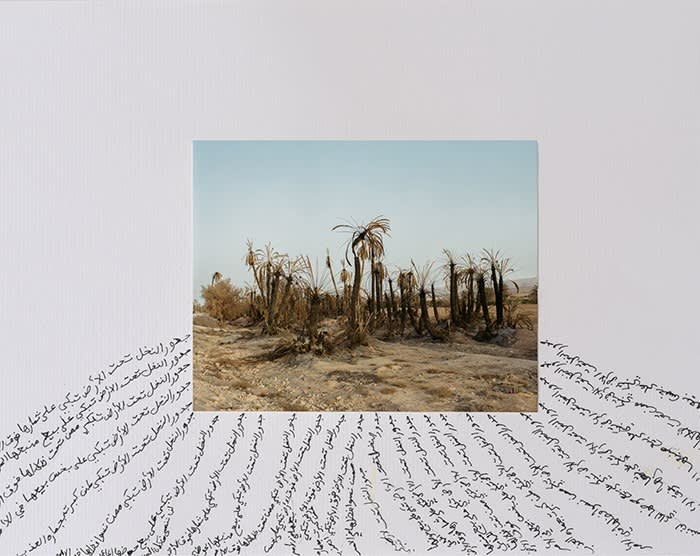Growing up, the Moroccan photographer Seif Kousmate had little emotional attachment to his country’s iconic oases. But, in adulthood, he recognised the significance of their decline. In his ongoing series Waha — Arabic for oasis — the artist investigates the precarious state of these sites as they succumb to the effects of unsustainable agricultural practices, silting, a shifting population and increased cycles of drought. Through a blend of documentation and imagination, his pictures survey the degradation of what have for centuries been seen as fertile idylls.
Works from Kousmate’s series feature at the New Visions photography and new media triennial at Henie Onstad Kunstsenter in Oslo, a showcase of work by a global array of artists concerned about the plundering of natural and man-made resources. The Waha pictures appraise a landscape in distress: there are arid irrigation ditches, trees used as clothes lines, teetering palms and sun-cracked houses. Figurative works detail the henna-marked hands of locals and the efforts of workmen clearing trenches and collecting seaweed to aid the flow of water. There are also portraits of the beleaguered inhabitants of these endangered places. The compositions pose a philosophical question as much as an environmental one: what is left when an oasis — a refuge — is undermined?
There is a stark reversal of fortunes here. For outsiders, an oasis is a scene loaded with notions of otherness and exoticism; it has become a byword for safety and sustenance. For north Africans, however, oases are also hubs of commerce and sites of traditional skills. “Behind the myths and orientalist representations lie systems, cultures, innovation and the human ingenuity of our ancestors,” Kousmate says. “We have managed to maintain a delicate and fragile balance between water, flora, soil and climate in this hostile environment that is the desert.” That equilibrium has changed dramatically: Morocco has lost two-thirds of its palm trees over the past century and a similar expanse of oasis habitat.
A self-taught photographer, Kousmate was born in 1988 in Essaouira on Morocco’s Atlantic coast and worked for several years as a civil engineer (although never with irrigation systems). He dedicated himself to photography in 2016 and has since focused on humanitarian subjects, such as the experiences of sub-Saharan immigrants and young people in Rwanda, projects that have been primarily documentary in style.


For Waha, however, Kousmate embraced more experimental and conceptual elements. Some of the pictures have been embellished with deliberate interventions — singeing, scarring, collaging — in order to extend the metaphor of degradation. Prints were burnt by fire and corroded with acid. Other works incorporate organic elements, such as dried dates, soil and the dead skin of palm trees. The overall effect is one of nature reeling, out of sync with its natural patterns.
In recent decades, water has gone from being a plentiful resource, as fundamental as food, oxygen and light, to a commodity under threat from a worsening environmental crisis, economic forces and human conflicts.
Kousmate’s photographs show this global devastation in miniature, as climate change and urbanisation impact these Moroccan ecosystems. “Demystifying this ‘miraculous’ aspect of these territories is what drew me to understand more what is happening in the oases right now, as they are experiencing a transition and an imbalance,” he explains.
As a coda to the images, one of the prints features, in calligraphic Arabic, the words of the Moroccan poet Ibrahim Rajeaa, a resident of the Tighmert oasis in southern Morocco: “Palm tree roots in the ground weep as their water springs are sold / Palm tree roots in the ground lament because of those who used to rest in their shade”. Yet, Kousmate maintains, there is still hope. The oases of southern Morocco are now included in the Unesco world network of biosphere reserves. While it’s affecting art, Waha is also advocating for change.


New Visions: The Henie Onstad Triennial for Photography and New Media runs until September 17 2023; hok.no/en
Follow @FTMag on Twitter to find out about our latest stories first
Stay connected with us on social media platform for instant update click here to join our Twitter, & Facebook
We are now on Telegram. Click here to join our channel (@TechiUpdate) and stay updated with the latest Technology headlines.
For all the latest Art-Culture News Click Here
